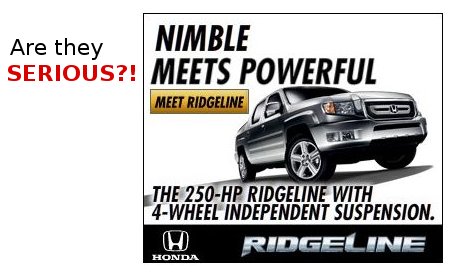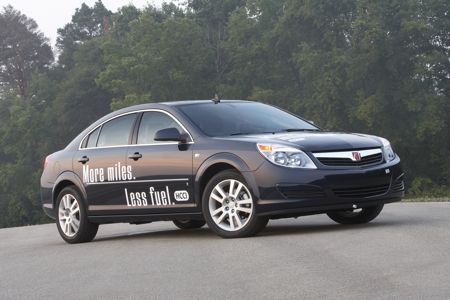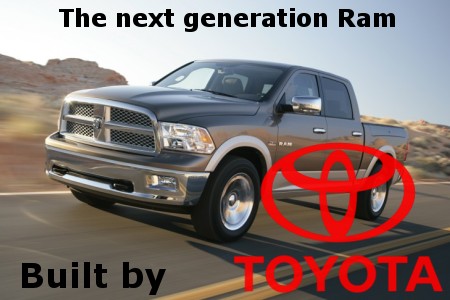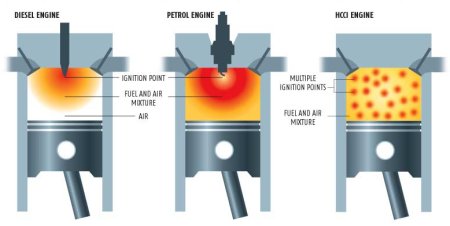 All Entries in the "Auto News" Category
All Entries in the "Auto News" Category
One Toyota Sequoia Please – Hold the Alligator
Picture this: You’re in the market for a Toyota Sequoia. You’re at the dealership. The salesperson throws you the keys and says “take it for a spin.” You go to open the front door and you notice something moving at your feet. Startled, you lean forward to take a look and BOOM! An 8 and a half foot alligator!

Toyota Sequoia with an alligator, courtesy Tampa Bay Online (TBO.com).
“I’d like to see the Sequoia *without* the alligator option please.“
Why Some Americans Hate Japanese Trucks – The Ridgeline
We’re constantly dealing with emails and comments here at TundraHeadquarters that all say something like (paraphrasing) “If U were a real truck owner, you wouldn’t buy a Jap rice burner truck, you’d get a real pickup from GM, Ford, or Dodge…” Right. That’s a pretty ignorant thing to say considering the Tundra is made in Texas, has more domestic content than trucks from Dodge or GM, and meets or exceeds the trucks offered by the not-so-big-three in almost every measurable way. The Tundra is, after all, the 2nd most American truck on the market today.
Still, we get hate mail. So be it. We’re fighting the good fight, trying to explain to loyal American truck buyers that the Tundra should stand right alongside it’s brethern from Detroit. Then, out of the blue, Honda goes and does something like this:

No wonder the Honda Ridgeline is hated by hard-core truck enthusiasts.
That’s a screen-shot of an advertisment for the Ridgeline – the “nimble yet powerful” truck.
Come-on Honda let’s be real! The ad says “Nimble Meets Powerful,” but that statement is bordering on an outright lie.
HCCI – Pros, Cons, and Predictions
Is Homogenous Charge Compression Ignition (HCCI) the next big thing for the auto industry? Will it be the perfect marriage of low emissions, high fuel economy, and performance? Probably not, but it very well could be a significant transition, that first step to pry us out of our gas-slurping speedsters without an insurmountable culture shock. [This is a follow-up to our article on HCCI from last week, Emerging Engine Technology – HCCI – What is it? Give it a read if you haven’t already or a lot of this won’t make sense.]

Saturn Aura with an HCCI engine.
In today’s auto market, a combination of desperation and advanced engine management systems has solved a lot of HCCI’s inherent problems. In May 2008, GM rolled out a Saturn Aura HCCI prototype, a hybrid of HCCI and traditional spark-ignition that delivers 15-percent gas savings with a 4-cylinder, 2.2-liter engine rated at 180 hp.
The response to the technology and the Aura is mixed. The greens don’t think it goes far enough in fuel savings and question the industry’s obsession with fossil-fuels. The performance side looks at the horsepower rating and sneers. So, let’s try to bridge the gap with the tried-and-true Pro and Con evaluation:
Toyota To Build Next-Generation Dodge Ram
The following post was an April Fools prank. Our apologies to any Dodge owners who got excited about buying a quality product! 🙂
Our sources have confirmed that a joint press conference will be held in the next few days announcing that the next generation Dodge Ram will be engineered, designed, and built by Toyota in San Antonio.

In an effort to save cash and stay afloat, Chrysler is sourcing the next generation Dodge Ram from Toyota.
Cost-cutting pressures and the realities of the modern auto industry have hit Chrysler hard. Late last year, Chrysler announced they were selling the Dodge Viper brand. In late January, Chrysler and Fiat announced a merger. Today, Dodge officially leaves the truck business.
This move makes sense for a few reasons:
Emerging Engine Technology – HCCI – What is it?
Engineers started fiddling around with HCCI (Homogeneous Charge Compression Ignition) in the late 1970s. While the possibilities that HCCI offered were intriguing (especially the fuel economy savings), the technology was too complicated for the time. HCCI research was relegated to the back shelf – until recently when the search for more efficient, eco-friendly gas-sipping engines became priority number one for the auto industry.
HCCI could very well be, if not THE answer to our gas price and oil consumption woes, at least a serious transition from current technology to some sort of future non-fossil fuel engine. What it is requires a little more explanation, and that explanation starts with what HCCI isn’t.

HCCI graphic from New Science magazine 2006.
With conventional gas engines, ignition of the fuel/air mixture is achieved with a spark.

